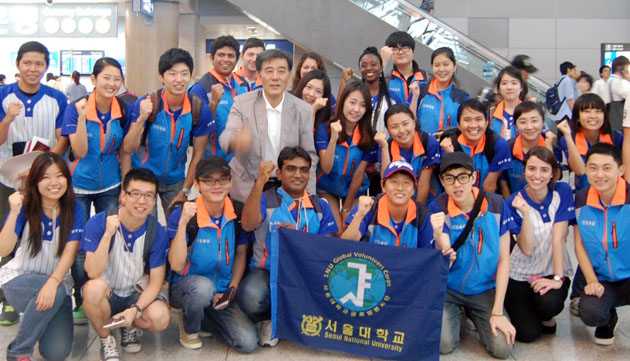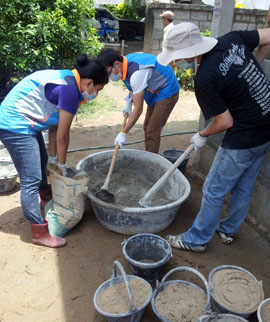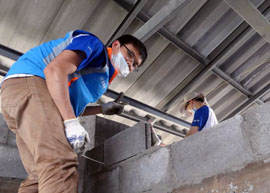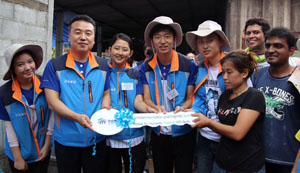Summer vacation is a great time to get away from the mundane routine of university life. You can pack your bags and travel to some unknown place, far from home. You can immerse yourself in a summer job and absorb new knowledge you usually wouldn’t acquire in school. Or, as in my case, you can volunteer in a foreign country and have an unforgettable summer.
On August 19 I traveled with 25 other Seoul National University (SNU) students to the northern city of Chiang Mai, Thailand on a program from Habitat for Humanity Korea to build a house for a local family. After preparing for two months prior to the trip, we finally embarked on our journey. Despite the corporeal exhaustion and other tension-filled moments, I can say that this trip was arewarding experience and the highlight of my summer.
The application process for the Global Volunteering program began in early July, with the SNU Student Affairs Office in charge of evaluating all applicants. Applicants ranged from international Korean students and foreign students to members of SHINE (student ambassadors) and SNU PhronesisNanoome (a community servicestudent group). Chosen as the leader of the SNU Habitat group, I was anxious and excited to be part of the first mixed international group with students from Korea, Sri Lanka, Germany, the USA, Malaysia, Ghana, and so on.

Preparing for Thailand
Firstly, the staff from Habitat for Humanity Korea came to SNU to inform us about the volunteer work we would be doing and other aspects of volunteering in a foreign country in general. During the orientation, we were told that part of the Habitat Korea program would consist of building a house for a family struggling with financial problems. Along with that, we were also told that part of the volunteering experience was cultural interaction.
Apart from the physical work, it is also important to learn about the culture of the country. Furthermore, not only is learning important but also teaching our culture to the people. The interaction between groups is important in fostering a diverse yet unified environment of mutual benefit. Keeping this in mind, our team began to prepare.
We decided to do a performance for the students of the village in which we would be working. We chose three songs that would reflect different cultures. First was Chang, a Thai nursery song, then Gom-Se-Mari, or the Three Bears Korean children’s song, and finally, We are the World to add an international classic to the mix. In our weekly meetings members learned all the dances that went along with the songs and in the end we all got lots of laughs from our efforts.
Traveling to Chiang Mai
All members met at the Incheon International Airport and with a few last words from the director of student affairs, we boarded the plane. After five hours we arrived at the Chiang Mai airport to be greeted by the Habitat Thailand staff workers. Soon, sleep overtook us and we prepared for the days of hard work to come.
Day 1: Establishing Foundations -- Welcoming Words and Dirt Transfers
 We were introduced to the family whose house we would be building. When we arrived at the village we met the family and saw the poor conditions that they were living in. Ms. Thunyapond gave a welcome speech in which she spoke of her gratitude for helping her family. In the middle of her speech, tears began to fall down her cheeks as she said “Thank you, for giving us this opportunity. Thank you.” I will never forget her emotion filled voice as she thanked us for giving her this opportunity to have a home. I realized that while our task was simply to do some construction work, for her it was a life-altering moment because she would finally have a home where her children could grow up, and where her parents could grow old. Inspired, we began the day’s work.
We were introduced to the family whose house we would be building. When we arrived at the village we met the family and saw the poor conditions that they were living in. Ms. Thunyapond gave a welcome speech in which she spoke of her gratitude for helping her family. In the middle of her speech, tears began to fall down her cheeks as she said “Thank you, for giving us this opportunity. Thank you.” I will never forget her emotion filled voice as she thanked us for giving her this opportunity to have a home. I realized that while our task was simply to do some construction work, for her it was a life-altering moment because she would finally have a home where her children could grow up, and where her parents could grow old. Inspired, we began the day’s work.
Our task for the day was to transfer dirt, which was piled up far away, to lay the foundation for the house. Some students shoveled dirt into buckets, which were passed down to the house to pile. Each bucket weighed about 8~9 kg each, and carrying it was strenuous labor. After half an hour of carrying the buckets, my back and shoulder muscles could feel the strain. But lunch was a great new experience. Ms. Thunyapond cooked all the food herself, which consisted of chicken, rice and a dish of tofu-pork stew. The Thai flavors satisfied our famished tummies and energized us for the work we had left. After lunch, the same dirt-transferring work continued until 3 PM, when we cleaned up and called it a day. Some reflections I had from Day One were that the job of moving buckets of dirt is challenging because of the monotony and physicality of the work. The lack of variety is not stimulating, therefore we got tired even more quickly.
Day 2: Mixing Cement for the Floors
On the second day we had to mix cement and level cement ground. We mixed sand, gravel, water and cement steadily until it had a certain consistency that would work for the floor. (The mixing looks simple, but in reality the cement mix is very heavy, so moving the hoe is harder than it looks.) Once thoroughly mixed, we poured this cement on the dirt ground that we made the day before so that the house could have cement floors.
One interesting thing I noticed was that once the floor was leveled the hard gravel pieces that we mixed in the cement were nowhere to be seen. It made me think that contrary to what the smooth surface suggests, hard pieces are lying inside so that the surface can emerge. In a way, that is reality. Behind everything there are hard rocks to support the smooth surface. Behind the volunteer program, there were administrative staff who worked hard to organize this trip for us students, and the result was the actualization of the trip.
 At the end of the second day I took off my gloves and as I was cleaning the sweat off my forehead, I saw everything we had accomplished. I was astonished to see all the work we had done in two days. The mountains of dirt we moved and packed to make the half-meter deep ground were impressive. On top of that we now had a smooth cement layer on the ground, where just yesterday morning there was nothing. Also, with the experience, the teamwork was better and all members were exponentially more synchronized. Like they say, practice makes perfect, and we were certainly on our way to reaching perfection.
At the end of the second day I took off my gloves and as I was cleaning the sweat off my forehead, I saw everything we had accomplished. I was astonished to see all the work we had done in two days. The mountains of dirt we moved and packed to make the half-meter deep ground were impressive. On top of that we now had a smooth cement layer on the ground, where just yesterday morning there was nothing. Also, with the experience, the teamwork was better and all members were exponentially more synchronized. Like they say, practice makes perfect, and we were certainly on our way to reaching perfection.
Day 3: Building Walls-- Laying Cement Blocks
Day Three was actually building walls with cement blocks. We mixed cement, and used it to “paste” the cement blocks onto the ground and up. We built walls surrounding the entire house, as well as for the bathroom and rooms inside. I could notice the exhaustion setting in among the team members as the third day marked the midpoint of the total number of construction days. It was harder to get people together and their weariness showed in their eyes. The half-way-there syndrome affected everybody as all members seemed to be getting more annoyed and frustrated. As team leader, I tried to ignore my sore muscles and banging headache and motivate the team to continue. At the end of the day we went to the hotel and cleaned up. The latter half of the work was still to come.
Days 4 + 5: Continuation of Laying Cement Blocks and Finishing Touches
The following day we carried out the same task of laying cement blocks for the walls. With the experience from the previous days, the work load and division appeared better, and everybody worked very efficiently.
 On the last day of work, Day Five, we continued the same task and finished the walls for the house. Around noontime, the director, dean, associate dean, and other administrators from the student affairs office came to the construction site. We had a house dedication ceremony where we passed a key to the new homeowner, a symbolic gesture of the transfer of ownership. Like the first day we arrived, Ms. Thunyapond cried big tears as she expressed her gratitude. She thanked all the SNU students for coming here to her village to build her a new home where her family would grow old. We hugged, took pictures, and I looked back and smiled. We had built not a house, but a home.A home that would be the place of security, of nurturing and of growth for all members of her family. With one last glance, I got into the van that quickly sped away.
On the last day of work, Day Five, we continued the same task and finished the walls for the house. Around noontime, the director, dean, associate dean, and other administrators from the student affairs office came to the construction site. We had a house dedication ceremony where we passed a key to the new homeowner, a symbolic gesture of the transfer of ownership. Like the first day we arrived, Ms. Thunyapond cried big tears as she expressed her gratitude. She thanked all the SNU students for coming here to her village to build her a new home where her family would grow old. We hugged, took pictures, and I looked back and smiled. We had built not a house, but a home.A home that would be the place of security, of nurturing and of growth for all members of her family. With one last glance, I got into the van that quickly sped away.
But our job was not done yet. We quickly drove to a local school where the elementary students performed a brave drum routine. In return, we performed the three songs we had prepared for so long. The children were shy but curious, and smiled easily at our awkward attempts at the Thai language. After our performance, we donated tennis shoes and school supplies for the children who looked as if Christmas had arrived early. Communicating only with body language we went out and played football and jump rope and ate ice cream.
Despite the tiring day of work, looking at these children laugh and giggle washed away all the soreness and fatigue. Although our interaction time with the children was short, I can’t help but feel like it was one of the greatest moments of the trip. The warmth that radiated from their innocent smiles, their eyes twinkling with joy… and with no words spoken at all. It is curious how, sometimes, even words become superfluous.
Reflections: Leaving with Much More in Return
 I came to Thailand thinking I would be giving someone a house they could not have otherwise. But in the process of building a new home for the family, I ended up receiving much more. Rarely in life do you get such a chance to broaden your mind and soul, to learn acceptance and understanding. Patience, especially for a leader, is definitely a virtue. Furthermore, an important lesson I learned was that practice really does help. For example during our fourth day of construction, I could see the improvement in everyone’s cementing skills which had come from practice from the previous day.
I came to Thailand thinking I would be giving someone a house they could not have otherwise. But in the process of building a new home for the family, I ended up receiving much more. Rarely in life do you get such a chance to broaden your mind and soul, to learn acceptance and understanding. Patience, especially for a leader, is definitely a virtue. Furthermore, an important lesson I learned was that practice really does help. For example during our fourth day of construction, I could see the improvement in everyone’s cementing skills which had come from practice from the previous day.
It was an interesting change to see the students whom I had always encountered in classrooms or on campus wearing pristine outfits, now with their hands and faces covered with dirt and sweating all over. It really made me contemplate the chameleon-like adaptability and the multifaceted ability in general that SNU students have when they are encountering different challenging tasks. Even outside of lecture halls, in a foreign country, we can unite to work for a common goal: to build a home.
There is a home in the northern city of Chiang Mai, Thailand. This home, a simple concrete building with two rooms, a bathroom, and a kitchen, will be the center for a beautiful family of five whose economic instability had left them bereft of a safe dwelling. A team of students, the SNU Habitat Team, traveled to this unknown country, hoping to give this family what they needed. Little did the students know that they would be leaving with so much more in return.
Written by OH Jung Eun, SNU English Editor, josefinaoh@snu.ac.kr
Reviewed by Eli Park Sorensen, SNU Professor of Liberal Studies, eps7257@snu.ac.kr
Proofread by Brett Johnson, SNU English Editor, morningcalm2@gmail.com

